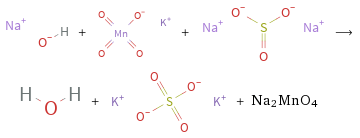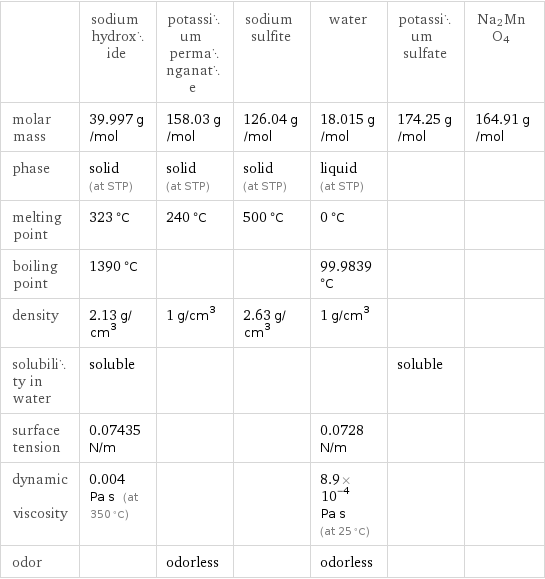Input interpretation

NaOH sodium hydroxide + KMnO_4 potassium permanganate + Na_2SO_3 sodium sulfite ⟶ H_2O water + K_2SO_4 potassium sulfate + Na2MnO4
Balanced equation

Balance the chemical equation algebraically: NaOH + KMnO_4 + Na_2SO_3 ⟶ H_2O + K_2SO_4 + Na2MnO4 Add stoichiometric coefficients, c_i, to the reactants and products: c_1 NaOH + c_2 KMnO_4 + c_3 Na_2SO_3 ⟶ c_4 H_2O + c_5 K_2SO_4 + c_6 Na2MnO4 Set the number of atoms in the reactants equal to the number of atoms in the products for H, Na, O, K, Mn and S: H: | c_1 = 2 c_4 Na: | c_1 + 2 c_3 = 2 c_6 O: | c_1 + 4 c_2 + 3 c_3 = c_4 + 4 c_5 + 4 c_6 K: | c_2 = 2 c_5 Mn: | c_2 = c_6 S: | c_3 = c_5 Since the coefficients are relative quantities and underdetermined, choose a coefficient to set arbitrarily. To keep the coefficients small, the arbitrary value is ordinarily one. For instance, set c_3 = 1 and solve the system of equations for the remaining coefficients: c_1 = 2 c_2 = 2 c_3 = 1 c_4 = 1 c_5 = 1 c_6 = 2 Substitute the coefficients into the chemical reaction to obtain the balanced equation: Answer: | | 2 NaOH + 2 KMnO_4 + Na_2SO_3 ⟶ H_2O + K_2SO_4 + 2 Na2MnO4
Structures

+ + ⟶ + + Na2MnO4
Names

sodium hydroxide + potassium permanganate + sodium sulfite ⟶ water + potassium sulfate + Na2MnO4
Equilibrium constant
![Construct the equilibrium constant, K, expression for: NaOH + KMnO_4 + Na_2SO_3 ⟶ H_2O + K_2SO_4 + Na2MnO4 Plan: • Balance the chemical equation. • Determine the stoichiometric numbers. • Assemble the activity expression for each chemical species. • Use the activity expressions to build the equilibrium constant expression. Write the balanced chemical equation: 2 NaOH + 2 KMnO_4 + Na_2SO_3 ⟶ H_2O + K_2SO_4 + 2 Na2MnO4 Assign stoichiometric numbers, ν_i, using the stoichiometric coefficients, c_i, from the balanced chemical equation in the following manner: ν_i = -c_i for reactants and ν_i = c_i for products: chemical species | c_i | ν_i NaOH | 2 | -2 KMnO_4 | 2 | -2 Na_2SO_3 | 1 | -1 H_2O | 1 | 1 K_2SO_4 | 1 | 1 Na2MnO4 | 2 | 2 Assemble the activity expressions accounting for the state of matter and ν_i: chemical species | c_i | ν_i | activity expression NaOH | 2 | -2 | ([NaOH])^(-2) KMnO_4 | 2 | -2 | ([KMnO4])^(-2) Na_2SO_3 | 1 | -1 | ([Na2SO3])^(-1) H_2O | 1 | 1 | [H2O] K_2SO_4 | 1 | 1 | [K2SO4] Na2MnO4 | 2 | 2 | ([Na2MnO4])^2 The equilibrium constant symbol in the concentration basis is: K_c Mulitply the activity expressions to arrive at the K_c expression: Answer: | | K_c = ([NaOH])^(-2) ([KMnO4])^(-2) ([Na2SO3])^(-1) [H2O] [K2SO4] ([Na2MnO4])^2 = ([H2O] [K2SO4] ([Na2MnO4])^2)/(([NaOH])^2 ([KMnO4])^2 [Na2SO3])](../image_source/be60ba7ddcb9562e2f8bad73679f92ef.png)
Construct the equilibrium constant, K, expression for: NaOH + KMnO_4 + Na_2SO_3 ⟶ H_2O + K_2SO_4 + Na2MnO4 Plan: • Balance the chemical equation. • Determine the stoichiometric numbers. • Assemble the activity expression for each chemical species. • Use the activity expressions to build the equilibrium constant expression. Write the balanced chemical equation: 2 NaOH + 2 KMnO_4 + Na_2SO_3 ⟶ H_2O + K_2SO_4 + 2 Na2MnO4 Assign stoichiometric numbers, ν_i, using the stoichiometric coefficients, c_i, from the balanced chemical equation in the following manner: ν_i = -c_i for reactants and ν_i = c_i for products: chemical species | c_i | ν_i NaOH | 2 | -2 KMnO_4 | 2 | -2 Na_2SO_3 | 1 | -1 H_2O | 1 | 1 K_2SO_4 | 1 | 1 Na2MnO4 | 2 | 2 Assemble the activity expressions accounting for the state of matter and ν_i: chemical species | c_i | ν_i | activity expression NaOH | 2 | -2 | ([NaOH])^(-2) KMnO_4 | 2 | -2 | ([KMnO4])^(-2) Na_2SO_3 | 1 | -1 | ([Na2SO3])^(-1) H_2O | 1 | 1 | [H2O] K_2SO_4 | 1 | 1 | [K2SO4] Na2MnO4 | 2 | 2 | ([Na2MnO4])^2 The equilibrium constant symbol in the concentration basis is: K_c Mulitply the activity expressions to arrive at the K_c expression: Answer: | | K_c = ([NaOH])^(-2) ([KMnO4])^(-2) ([Na2SO3])^(-1) [H2O] [K2SO4] ([Na2MnO4])^2 = ([H2O] [K2SO4] ([Na2MnO4])^2)/(([NaOH])^2 ([KMnO4])^2 [Na2SO3])
Rate of reaction
![Construct the rate of reaction expression for: NaOH + KMnO_4 + Na_2SO_3 ⟶ H_2O + K_2SO_4 + Na2MnO4 Plan: • Balance the chemical equation. • Determine the stoichiometric numbers. • Assemble the rate term for each chemical species. • Write the rate of reaction expression. Write the balanced chemical equation: 2 NaOH + 2 KMnO_4 + Na_2SO_3 ⟶ H_2O + K_2SO_4 + 2 Na2MnO4 Assign stoichiometric numbers, ν_i, using the stoichiometric coefficients, c_i, from the balanced chemical equation in the following manner: ν_i = -c_i for reactants and ν_i = c_i for products: chemical species | c_i | ν_i NaOH | 2 | -2 KMnO_4 | 2 | -2 Na_2SO_3 | 1 | -1 H_2O | 1 | 1 K_2SO_4 | 1 | 1 Na2MnO4 | 2 | 2 The rate term for each chemical species, B_i, is 1/ν_i(Δ[B_i])/(Δt) where [B_i] is the amount concentration and t is time: chemical species | c_i | ν_i | rate term NaOH | 2 | -2 | -1/2 (Δ[NaOH])/(Δt) KMnO_4 | 2 | -2 | -1/2 (Δ[KMnO4])/(Δt) Na_2SO_3 | 1 | -1 | -(Δ[Na2SO3])/(Δt) H_2O | 1 | 1 | (Δ[H2O])/(Δt) K_2SO_4 | 1 | 1 | (Δ[K2SO4])/(Δt) Na2MnO4 | 2 | 2 | 1/2 (Δ[Na2MnO4])/(Δt) (for infinitesimal rate of change, replace Δ with d) Set the rate terms equal to each other to arrive at the rate expression: Answer: | | rate = -1/2 (Δ[NaOH])/(Δt) = -1/2 (Δ[KMnO4])/(Δt) = -(Δ[Na2SO3])/(Δt) = (Δ[H2O])/(Δt) = (Δ[K2SO4])/(Δt) = 1/2 (Δ[Na2MnO4])/(Δt) (assuming constant volume and no accumulation of intermediates or side products)](../image_source/d43f5a2472669c2e0265d4f4b0460253.png)
Construct the rate of reaction expression for: NaOH + KMnO_4 + Na_2SO_3 ⟶ H_2O + K_2SO_4 + Na2MnO4 Plan: • Balance the chemical equation. • Determine the stoichiometric numbers. • Assemble the rate term for each chemical species. • Write the rate of reaction expression. Write the balanced chemical equation: 2 NaOH + 2 KMnO_4 + Na_2SO_3 ⟶ H_2O + K_2SO_4 + 2 Na2MnO4 Assign stoichiometric numbers, ν_i, using the stoichiometric coefficients, c_i, from the balanced chemical equation in the following manner: ν_i = -c_i for reactants and ν_i = c_i for products: chemical species | c_i | ν_i NaOH | 2 | -2 KMnO_4 | 2 | -2 Na_2SO_3 | 1 | -1 H_2O | 1 | 1 K_2SO_4 | 1 | 1 Na2MnO4 | 2 | 2 The rate term for each chemical species, B_i, is 1/ν_i(Δ[B_i])/(Δt) where [B_i] is the amount concentration and t is time: chemical species | c_i | ν_i | rate term NaOH | 2 | -2 | -1/2 (Δ[NaOH])/(Δt) KMnO_4 | 2 | -2 | -1/2 (Δ[KMnO4])/(Δt) Na_2SO_3 | 1 | -1 | -(Δ[Na2SO3])/(Δt) H_2O | 1 | 1 | (Δ[H2O])/(Δt) K_2SO_4 | 1 | 1 | (Δ[K2SO4])/(Δt) Na2MnO4 | 2 | 2 | 1/2 (Δ[Na2MnO4])/(Δt) (for infinitesimal rate of change, replace Δ with d) Set the rate terms equal to each other to arrive at the rate expression: Answer: | | rate = -1/2 (Δ[NaOH])/(Δt) = -1/2 (Δ[KMnO4])/(Δt) = -(Δ[Na2SO3])/(Δt) = (Δ[H2O])/(Δt) = (Δ[K2SO4])/(Δt) = 1/2 (Δ[Na2MnO4])/(Δt) (assuming constant volume and no accumulation of intermediates or side products)
Chemical names and formulas

| sodium hydroxide | potassium permanganate | sodium sulfite | water | potassium sulfate | Na2MnO4 formula | NaOH | KMnO_4 | Na_2SO_3 | H_2O | K_2SO_4 | Na2MnO4 Hill formula | HNaO | KMnO_4 | Na_2O_3S | H_2O | K_2O_4S | MnNa2O4 name | sodium hydroxide | potassium permanganate | sodium sulfite | water | potassium sulfate | IUPAC name | sodium hydroxide | potassium permanganate | disodium sulfite | water | dipotassium sulfate |
Substance properties

| sodium hydroxide | potassium permanganate | sodium sulfite | water | potassium sulfate | Na2MnO4 molar mass | 39.997 g/mol | 158.03 g/mol | 126.04 g/mol | 18.015 g/mol | 174.25 g/mol | 164.91 g/mol phase | solid (at STP) | solid (at STP) | solid (at STP) | liquid (at STP) | | melting point | 323 °C | 240 °C | 500 °C | 0 °C | | boiling point | 1390 °C | | | 99.9839 °C | | density | 2.13 g/cm^3 | 1 g/cm^3 | 2.63 g/cm^3 | 1 g/cm^3 | | solubility in water | soluble | | | | soluble | surface tension | 0.07435 N/m | | | 0.0728 N/m | | dynamic viscosity | 0.004 Pa s (at 350 °C) | | | 8.9×10^-4 Pa s (at 25 °C) | | odor | | odorless | | odorless | |
Units
